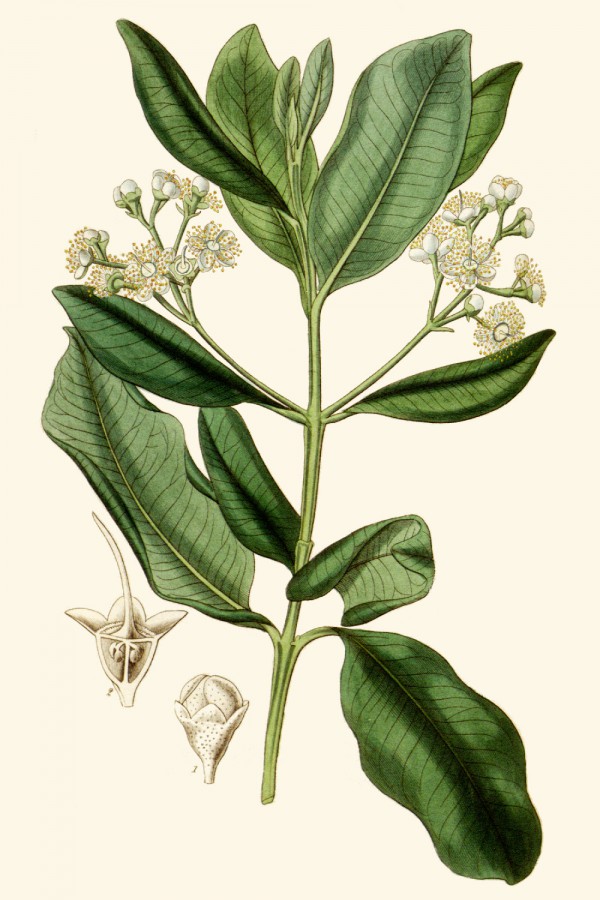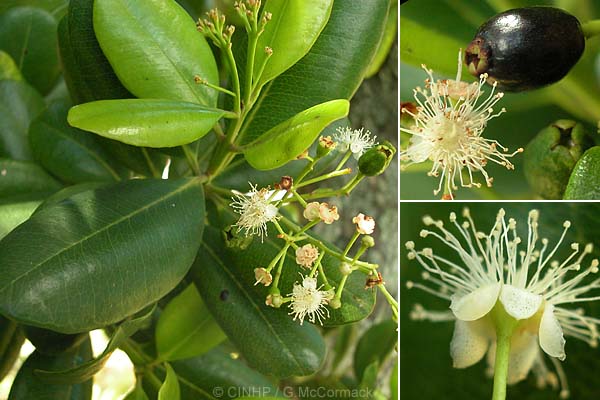Pimenta racemosa (Mill.) J.W.Moore - syn. Caryophyllus racemosus Mill.; Myrtus acris Sw.; Pimenta acris (Sw.) Kostel. - Myrtaceae
bayrum tree, West Indian bay, Bayrumbaum, Bay, Westindischer Lorbeer
Evergreen tree, 4-12m tall, native to the Caribbean; leaves obovate to oblanceolate or elliptic, shiny above, dull and pale beneath; cymes pedunculate; flowers white; fruit ovoid, ca 7-12mm long, black at maturity.
http://www.hear.org/pier/species/pimenta_racemosa.htm
„In some countries, especially in the Caribbean, the leaf oil is extracted into rum, which is then distilled to make Bay Rum, a fragrant cologne and perfume. The Bay Rum Tree should not be confused with the Bay Tree, Sweet Bay, or Bay Laurel (Laurus nobilis), the source of the Bay Leaf used in cooking.“
http://cookislands.bishopmuseum.org/species.asp?id=6538
„Bay oil exudes a strong spicy fragrance, reminiscent of clove oil. The antiseptic action is demonstrated, and therefore, the oil is often used in a cold together with eucalyptus oil for bath and inhalations.“
There are five varieties:
Pimenta racemosa var. grisea (Kiaersk.) Fosberg = syn. Pimenta acris var.grisea (eastern hispaniola, Virgin Islands)
Pimenta racemosa var. hispaniolensis (Urb.) Landrum (endemic to hispaniola)
Pimenta racemosa var. ozua (Urb. & Ekman) Landrum = syn. Pimenta ozua (Urb. & Ekman) Burret (endemic to northern-central hispaniola)
Pimenta racemosa var. racemosa = syn. Pimenta acris auct.; Caryophyllus racemosus Mill. (Caribbean, Venezuela)
Pimenta racemosa var. terebinthina (Burret) Landrum = syn. Pimenta terebinthina Burret) (endemic to northeastern hispaniola)
http://de.wikipedia.org/wiki/Bay
Fractionated distillation of bay oil lead to the isolation of a compound that polymerised quickly, which was called myrcene (from Myrcia acris = Pimenta acris = Pimenta racemosa). As constituents of bay oil were recognized eugenol, myrcene, chavicol, methyl eugenol, methyl chavicol, phellandrene, and citral.
[Power, B., Kleber, C., „On the constituents of oil of bay.“ Pharm. Rundsch, New York, 13 (1895); also in: Fritzsche Brothers, Circulars of information No.6, 1894]
„The foliar essential oils of Pimenta racemosa (Miller) J. Moore var. grisea (Kiaerskov) Fosb. are dominated by geraniol (0-85.52%), methyl eugenol (0.30-92.60%), and/or trans-methyl isoeugenol (0-86.32%). The foliar essential oils of Pimenta racemosa var. hispaniolensis (Urban) Landrum are dominated by 1,8-cineole (0.05-37.96%), methyl chavicol (0-22.61%), methyl eugenol (0-63.88%), γ-terpinene (0-16.67%), terpinen-4-ol (0.08-28.98%), and/or thymol (0-44.02%). The foliar essential oils of Pimenta racemosa var. ozua (Urban & E. Ekman) Landrum are dominated by 1,8-cineole (47.24-55.93%), limonene (3.62-30.07%), and/or α-terpineol (6.68-15.12%). The commercial bay oil (P. racemosa var. racemosa) is dominated by chavicol (<0.01-15.51%), eugenol (44.41-68.93%), methyl eugenol (0-11.88%), and/or myrcene (0.10-16.17%).“
[Volatile leaf oils of Caribbean Myrtaceae. I. Three varieties of Pimenta racemosa (Miller) J. Moore of the Dominican Republic and the commercial bay oil., Tucker, A. O., Maciarello, M. J., Adams, R. P., Landrum, L. R., Zanoni, T. A., Journal of Essential Oil Research, Vol.3(5), 1991, 323-329]
The main components of the essential oil of Pimenta racemosa leaves (“bay oil”) from Jamaica were eugenol
(45.6%), myrcene (24.9%), chavicol (9.3%), limonene (2.9%), linalool (2.2%), and methyl eugenol (1.0%).
[Jirovetz, L., Buchbauer, G., Stoilova, I., Krastanov, A., Stoyanova, A., & Schmidt, E. (2007). Spice plants: Chemical composition and antioxidant properties of Pimenta Lindl. essential oils, part 2: Pimenta racemosa (Mill.) JW Moore leaf oil from Jamaica. NUTRITION-VIENNA-, 31(7/8), 293]

Pimenta racemosa as Myrcia acris
Curtis’s Botanical Magazine, t.3123-3205, vol.59 [ser.2, vol.6] t.3153 (1832) [S.T.Edwards]
http://botanicalillustrations.org/species.php?id_species=792746

Pimenta racemosa; McCormack, Gerald (2007) Cook Islands Biodiversity Database, Version 2007.2.
Cook Islands Natural Heritage Trust, Rarotonga. Online at http://cookislands.bishopmuseum.org.